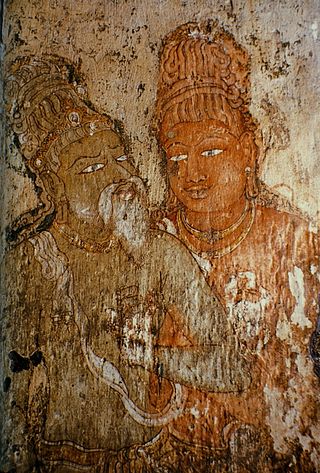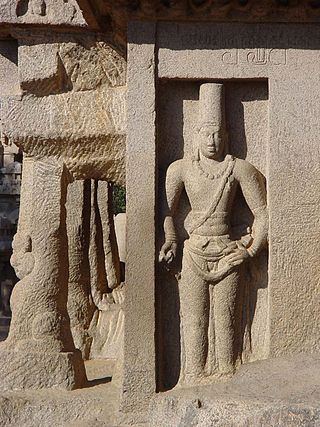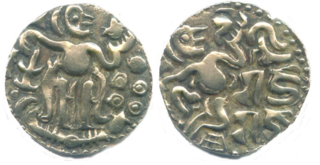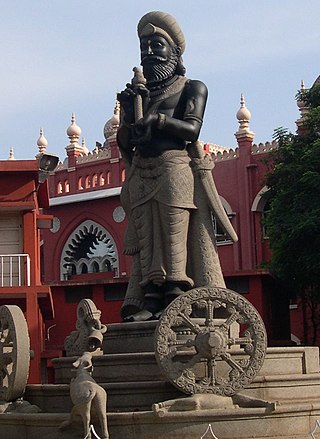Related Research Articles

Vikramaditya II was the son of King Vijayaditya and ascended the Badami Chalukya throne following the death of his father. This information comes from the Lakshmeshwar inscriptions in Kannada dated 13 January 735 A.D. From inscriptions it has come to be known that even before his coronation, Vikramaditya II, as a crown prince (Yuvaraja), had conducted successful military campaigns against their arch enemy, the Pallavas of Kanchipuram. His most important achievements were the capture of Kanchipuram on three occasions, the first time as a crown prince, the second time as an emperor and the third time under the leadership of his son and crown prince Kirtivarman II. This is attested to by another Kannada inscription, known as the Virupaksha Temple inscription which alludes to the emperor as the conqueror of Kanchi on three occasions and reads Sri Vikramaditya-bhatarar-mume-Kanchiyan-mume parajisidor. The other notable achievement was the consecration of the famous Virupaksha Temple and Mallikarjuna Temple by his queens Lokadevi and Trilokadevi at Pattadakal. These two monuments are the centre piece of the UNESCO World Heritage Monuments at Pattadakal. Vikramaditya II was a powerful ruler and was in power for 40 years. In order to maintain peace he entered into marriage alliance with Rashtrakutas.

Rajaraja I, also known as Rajaraja the Great, was a Chola emperor who reigned from 985 CE to 1014 CE. He is known for his conquests of southern India and parts of Sri Lanka, and increasing Chola influence across the Indian Ocean. Rajaraja's birth name was Arulmozhi Varman.

Narasimhavarman I was a Pallava emperor who reigned from 630 CE to 668 CE. He shared his father Mahendravarman I's love of art and completed the works started by Mahendravarman in Mamallapuram. During his reign, the famous Pancha Rathas, a monolithic rock-cut temple complex and a UNESCO World Heritage Site was constructed.

Rajadhiraja Chola I was a Chola emperor, as the successor of his father, Rajendra I. He was the only Chola emperor who was killed while leading his army in war, and although he had a short reign, he helped his father conquer several territories as well as to maintain the Chola authority over most of Sri Lanka, Eastern Chalukya and Kalinga, among others. He also established imperial relations with overseas allies despite a series of revolts in the territory.

Ellalan, also referred to as Elara the Pious, and by the honorific epithet Manu Needhi Cholan, was a member of the Tamil Chola dynasty in Southern India, who upon capturing the throne became king of the Anuradhapura Kingdom, in present-day Sri Lanka, from 205 BCE to 161 BCE.
Kalinga Magha or Gangaraja Kalinga Vijayabahu was an invader from the Kingdom of Kalinga who usurped the throne from Parakrama Pandyan II of Polonnaruwa in 1215. A massive migration followed of Sinhalese people to the south and west of Sri Lanka, and into the mountainous interior, as they attempted to escape his power. Magha was the last ruler to have his seat in the traditional northern seat of native power on the island, known as Rajarata; so comprehensive was his destruction of Sinhalese power in the north that all of the successor kingdoms to Rajarata existed primarily in the south of the island.
Vijayabahu the Great, also known as Vijayabahu I, was a medieval king of Sri Lanka. Born to a royal bloodline, Vijayabahu grew up under Chola occupation. He assumed rulership of the Ruhuna principality in the southern parts of the country in 1055. Following a seventeen-year-long campaign, he successfully drove the Cholas out of the island in 1070, reuniting the country for the first time in over a 77 years later. During his reign, he re-established Buddhism in Sri Lanka and repaired much of the damage caused to infrastructure during the wars. He offered the Thihoshin Pagoda(Lord of Sri Lanka Buddha image) to Burma king Alaungsithu and it is now still in Pakokku.
Valagamba, also known as the Great Black Lion, Wattagamani Abhaya and Valagambahu, was a king of the Anuradhapura Kingdom of Sri Lanka. Five months after becoming king, he was overthrown by a rebellion and an invasion from South India, but regained the throne by defeating the invaders fourteen years later. He is also known for the construction of the Abhayagiri Dagaba & Aluthepola Ganekanda Raja Maha Vihara.

The Anuradhapura period was a period in the history of Sri Lanka of the Anuradhapura Kingdom from 377 BCE to 1017 CE. The period begins when Pandukabhaya, King of Upatissa Nuwara moved the administration to Anuradhapura, becoming the kingdom's first monarch. Anuradhapura is heralded as an ancient cosmopolitan citadel with diverse populations.

The Chola conquest of Anuradhapura was a military invasion of the Kingdom of Anuradhapura by the Chola Empire. The period of Chola entrenchment in entire Sri Lanka lasted in total about three-quarters of a century, from roughly 993 CE to 1070 CE, when Vijayabahu I recaptured the north,east and central Sri lanka and expelled the Chola forces restoring Sinhalese sovereignty.
Chattagahaka Jantu was king of Anuradhapura for about one year from 434 AD to 435 AD. He succeeded his wife's stepbrother Soththisena and was succeeded by Mittasena.
Mittasena was King of Anuradhapura in the 5th century, whose reign lasted from 435 to 436. He succeeded Chattagahaka Jantu as King of Anuradhapura. During his reign, the kingdom was invaded by Pandu of The Six Dravidians. He was the last king of the Lambakanna dynasty.
Aggabodhi II was King of Anuradhapura in the 7th century CE. His reign lasted from 608 to 618 CE.
Aggabodhi III was King of Anuradhapura in the 7th century, whose reign lasted the year 623 and from 624 to 640. He succeeded his father Silameghavanna as King of Anuradhapura.
Kassapa II was the King of Anuradhapura in the 7th century, whose reign lasted from 650 to 659. He succeeded Dathopa Tissa I as King of Anuradhapura and was succeeded by Dappula I.
Unhanagara Hatthadatha was a king of Anuradhapura in 691. Despite his title, he was more of a good Buddhist monarch, with real power being held by a Tamil minister named Poththakutta who also commanded a significant number of Tamil mercenaries garrisoned in the city. He was placed in succession to deceased Aggabodhi IV and his reign caused further anarchy and discontent among the Buddhist Sinhalese majority of Anuradhapura and nearby.
Aggabodhi V was King of Anuradhapura in the 8th century, whose reign lasted from 726 to 732. He succeeded his father Manavanna as King of Anuradhapura and was succeeded by his brother Kassapa III.
Mahinda I, known colloquially as Midel, was King of Anuradhapura in the 8th century, whose reign lasted from 738 to 741. He succeeded his brother Kassapa III as King of Anuradhapura and was succeeded by his nephew Aggabodhi VI.
Aggabodhi VII was King of Anuradhapura in the 8th century, whose reign lasted from 781 to 787. He succeeded his cousin Aggabodhi VI as King of Anuradhapura and was succeeded by Mahinda II. His father was King Mahinda I.

Srimara Srivallabha (Tamil:சீமாறன் சீவல்லபன்) was a Pandya king of early medieval south India.
References
- ↑ Codrington, H. W. (1994). A short history of Ceylon. New Delhi, Madras, India: Asian Educational Services. ISBN 81-206-0946-8. OCLC 37378509.
